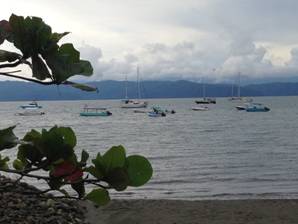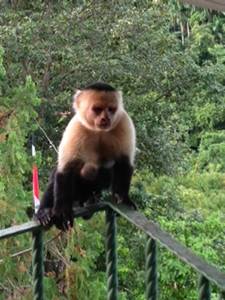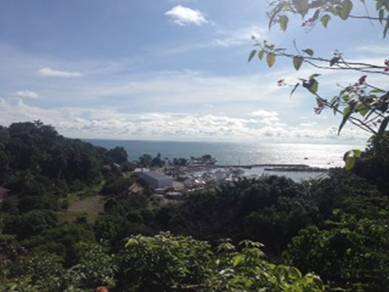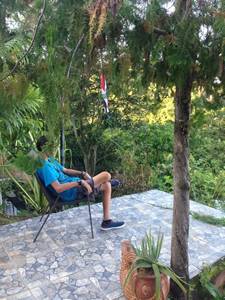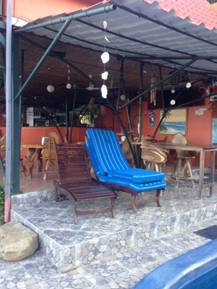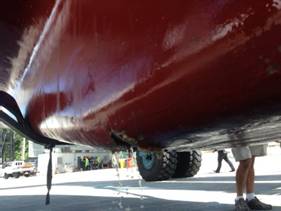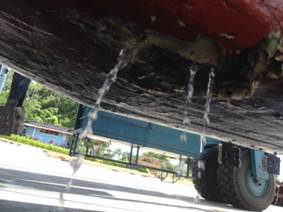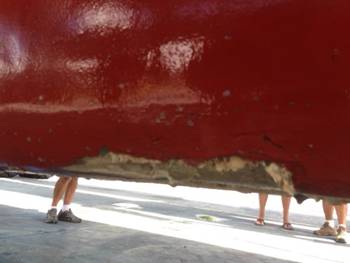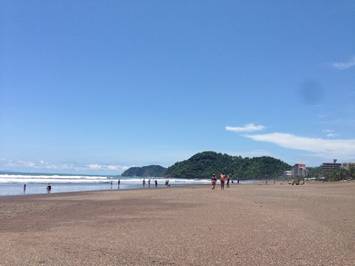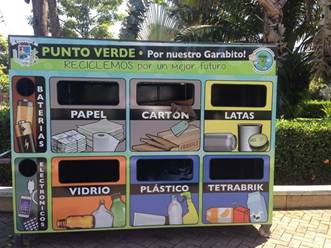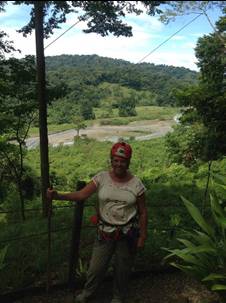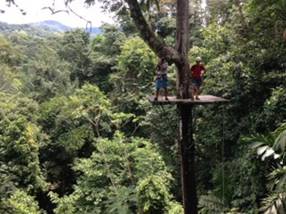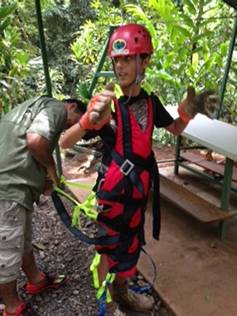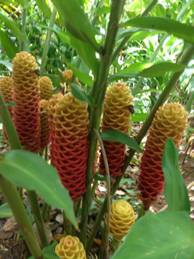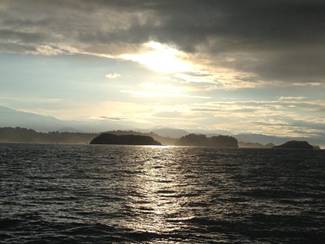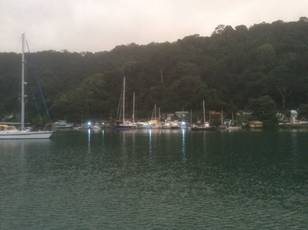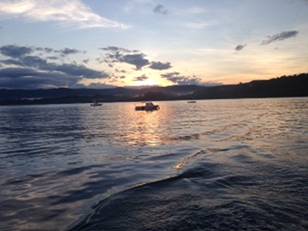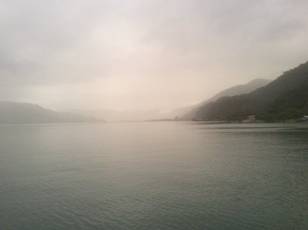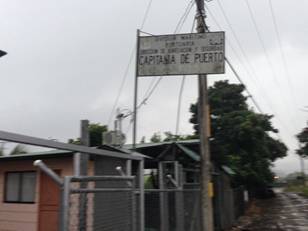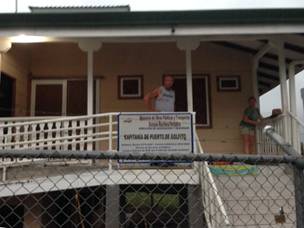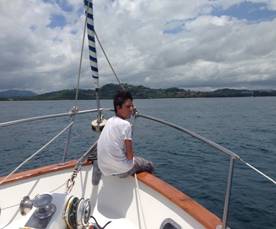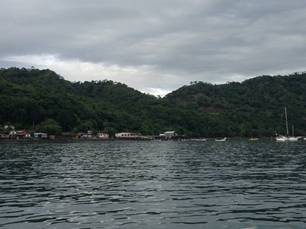FW: Blog Post 46 - Things Only Got Worse...Hitting a Reef in Tamarindo, Costa Rica

|
From: JIRIG [mailto:savarona {CHANGE TO AT} mailasail {DOT} com] Blog Post 46 – Things Only Got Worse…..Hitting a Reef in Tamarindo, the cruise from Playa Del Coco to Puerto Jimenez, Costa Rica 8/27/16 – 9/10/16 09.25.52N – 84.10.09W You know it is going to be a bad day when you wake up to your husband yelling “Teresa get up, I need your help, right away!” Remember the awesome, super powerful water pump Jirig found in the rusted out old container in Playa Cocos? Well….it was a little too powerful. Jirig woke up to the sound of water running and could not figure out where it was coming from. He finally found it. It was coming from behind the ice maker. The pump he installed the day before was very powerful and produced much more pressure than our previous one. It was so powerful it busted the clamp on the water hose that feeds the ice maker. Water had been running all night. On our boat most of the storage areas or lockers are connected. So if water leaks in one, it quickly gets everywhere. When we pulled out the ice maker there was water everywhere. It had leaked thru to the storage locker where I keep our food dry goods and into the one next to it that had all the Christmas decorations and some Halloween costumes. Everything had to be pulled out, dried, cleaned and repacked. Most of the decorations were ruined. Thankfully I keep all of our dry goods in large plastic storage containers with lids, so the damage was minimal there. The pressure on the water pump had to be readjusted. So back to no water, we were still having issues with the generator and our house batteries that power the inverter, which in turn, powers all electrical outlets on the boat, were not working. What else could go wrong you ask?......You can injure yourself, that's what! I was getting some paper towels out of a storage locker underneath the table in the salon when I knocked a huge and heavy fire extinguisher off its cradle and it landed a direct hit on my baby toe. It hurt so bad it brought tears to my eyes. It was a pressure injury, the kind you get when you slam your finger in a door. It was throbbing something fierce. I was definitely going to lose the nail on that toe. I am a trooper and can handle just about anything but I was about to Flipping lose it! We had no power, no water and I am in so much pain I can think or do nothing else. Jirig was furiously working getting everything fixed so I was not going to get any sympathy from him. Naturally, Nico has slept through everything... I went to his stateroom and crawled in bed with him. As I lay on his shoulder, I burst into tears. I explained to him what had happened and why I was crying and he in his wise, warm and kind voice said “its ok, mom, everything is going to be alright, we can deal with this…..”. There are two basic needs I require, ice and a fan. That is not too much to ask I don't think? Well, I had neither. It was 95 degrees in the cabin and it had just started to rain…..It was time to just suck it up and deal with it. I got up out of his bed and tried to make breakfast with the limited resources I had. At breakfast we discussed where we would stop next. Our son Daniel had told us about this great title surf town called Tamarindo, which had a fabulous beach. After spending months in a muddy estuary in El Salvador all we wanted to do was play in some nice clear water and do some snorkeling. Tamarindo is gringo central for northern Costa Rica. That might sound off putting to some but after the slim pickings for food and restaurants in El Salvador we were ready to avail ourselves of some nice restaurants and a good provisioning run. There was Indian, Japanese, Mexican and vegetarian restaurants. There were nice bars and a decent music scene. There were nice shops and boutiques. It was music to our ears. We were headed for Tamarindo, gourmet food and groceries. It also has the best surf break in Northern Costa Rica. It was a short sail, just 4 hours. As we sailed into the bay we were thrilled. The water was clear to 50 feet; we could see our anchor as it set in the sand. We immediately took the dinghy off of the davits and got the snorkeling gear. As it was a surf beach it was not safe to land the dinghy so we anchored it in about 10 feet of water and proceeded to snorkel around the rocks. As often happens at this time of year in Costa Rica, thunder heads had started to form and the surf kicked up. If you remember in previous posts, I have written about the fact that great surfing beaches do not make great anchorages? How our memories fade over time. The wind and the swells were fierce getting back to the boat. Waves were crashing over the bow of the dinghy. By the time we made it back to the boat, it had turned sideways and was now directly in the path of the swells. The boat was pitching and rolling so bad it was extremely dangerous to try to tie the dinghy to the boat and climb on. I am clumsy on a good day, add to that 5 ft seas and 30 knot winds and a tiny ladder leading up the boat and it is a recipe for disaster. My foot got caught in the ladder rungs and I almost took a dive. It a spurt of survival instincts, I righted myself just in time, and scrambled up the ladder. By now it was pouring rain. Oh, did I mention that when we left the boat we left all the windows and hatches open? I did so because there was no hint of rain and if you close the boat up it gets stiflingly hot in there and as we were still having power issues we had no fans to cool it off. Will we ever learn???….now I have another mess to clean up. With the storm now raging the swells were getting worse. We had planned to have a nice BBQ lunch but with the boat moving so much that was impossible. We have a gauge that measures the rolling side to side and the boat was pitching 25 degrees from side to side. Our salon windows were almost touching the water. It got to the point where you could not stand up. It was only getting worse, so we decided to leave. We would rather be out in the ocean in these conditions rather than sitting in an anchorage with 6ft swells hitting the side of the boat. We would never be able to sleep anyway. Jirig started the engines, I prepared the boat to sail and Nico pulled up the anchor. We were getting the hell out of here.
In our haste to get out of Tamarindo Bay we did not go out the way we came in and just headed directly out to sea. Big mistake! All of a sudden there was this horrific, thunk under the hull and then a loud scraping sound. It was a gut wrenching sound. We all knew what had happened…..we had hit a reef. A sailor’s worst nightmare. Nico was down in our stateroom watching a movie and he came flying up the stairs, his eyes bulging out of his head with a panicked look on his face.”What just happened, mom?” The captain had to make an instant decision. Do we keep going or do we try to turn around, what to do? It was such a terrible feeling. Nobody said a word. It's times like this that I am so glad I am not the captain…. We knew we had damaged the boat; there was no way that the sound we heard was not a rock or reef. One of the problems with cruising Central America is that the coast has not been surveyed since the late 1800’s and that was by the British Navy, the charts are that old. This reef was not on the charts. Jirig decided to keep going. He checked the engine room and it appeared that the hull had not been breached, but under the displacement keel had. We were taking on water. We have 4 powerful bilge pumps and an emergency pump that can pump out 33 gallons of water per minute. We should be able to pump out any water coming in. To return to the town of Tamarindo did us no good. It was a tourist town and would have no resources for us to repair any damage to the boat. We had to head for Quepos, Costa Rica. Quepos had the only state of the art boat yard in Central America. We were so lucky that we were only 110 miles away. We also needed to get to a safe anchorage so Jirig could dive under the boat and assess the damage. We headed for Bahia Ballena, 95 miles south. Meanwhile Jirig continuously checked the engine room and the bilge pumps and I looked for signs of water coming into the cabin. It was now dark so we headed off shore to avoid the dangers of the coastline. It would be an overnight trip with a damaged boat. I was scared shitless. It was dark, the boat was damaged but we did not know how badly. It was going to be a long night. Can we catch a Flipping break? I guess not. We all hunkered down and trudged on. We arrived in Bahia Ballena at around 7AM. We were exhausted. Neither of us had slept all night. Jirig got out his dive gear and I got to work making a hearty breakfast. I find that when things go to shit, if the crew can at least have a good meal everyone's attitude improves. So French toast and bacon it was. After breakfast Jirig and Nico went diving under the boat. The water was murky but he brought the Go Pro and filmed the hull of the boat. It was bad. The damage was significant. We do not have a keel on our boat. We have what they call a displacement hull. It is not as long and deep as a keel, it is square and more solid than a keel. The outer hull is fiberglass and then there is a thick layer of concrete for displacement (weight) then more fiberglass. The initial hit to the reef had made a large gouge and then 5 smaller scrapes along the displacement hull as we bounced over the reef. It was obvious that we needed to get the boat hauled out and repaired, es muy pronto! We had 2 options. We could go to Punta Arena, a dump of a port and boat yard, that had definitely seen better days or head to Marina/Boat Yard Pez Vela, in Quepos. The problem with Pez Vela is that it is 5 Star marina and extremely expensive. We assumed the boat yard would be the same. I reached out to my cruiser network and asked our friends which was better. All responses were, hands down, Pez Vela. Punta Arena had a decrepit travel lift and we would be sitting in the mud at low tide. The tides in CR are extreme and in many places when the tide goes out all there is left is mud. They also have a rodent problem. Fellow cruiser friends from SV Peregrina had just been there and had picked up a large rat. No thank you! We contacted Pez Vela by phone and luckily they had space in the marina and the boat yard could take us in and haul us out as soon as we got there and get us into the boatyard immediately. We spent the day in the anchorage, Bahia Ballena and true to its name; we saw Humpback whales frolicking in the sea all day. We finally got some sleep, Nico in our room just in case, and got up at first light and headed for Quepos, keeping a close eye on the bilge pumps. Given the damage we observed, we were very surprised that there was not more water in the bilge. We never had to use more than 2 of our 4 bilge pumps to manage the water. For you non-boaters out there….don't freak out. Contrary to popular belief all boats take on some water and bilge pumps are designed and built to deal with it quite effectively. And we still had the beast of a back up pump if we needed it. We limped into Pez Vela and tied up to their guest dock for the night. As we got there late, after the office had closed, we could not get a power hookup or the wifi code. We spent another stifling hot night on the boat. Poor Nico was so looking forward to be in a marina with wifi and was sorely disappointed when he could not access it. Jirig was up early and was busy doing boat repairs waiting for the boatyard to open. We spent the day working out the haul out and repairs with the marina office and checking into the port. I cannot say enough positive adjectives about Marina Pez Vela. They were amazing. Given their 5 star marina resort status we were expecting a snooty, smug reception. Usually marinas like this are not welcoming to transient sailboats. Their money is made with million dollar sport fishing yachts that stay there year round. Their owners show up once or twice a year to fish. Rag tag sailing boats are not their cup of tea you might say. We could not have been more wrong in our preconceptions. They were awesome. They did not take advantage of our urgent situation as they could have. The marina and boatyard manager, Carter Takacs, and his team were amazing. So helpful, respectful and considerate. Boatyards as a rule are not nice places to stay and most of the time they are toxic waste dumps. This boat yard was very professional and absolutely spotless. After all, this is Costa Rica. They take this stuff seriously. No hazardous waste released in this yard. Pura Vida and all that crap. Got to give them credit though, they ran a top notch operation. We had no intention nor would their yard allow it, for us to stay on the boat while it was in the yard. I got on my IPad and starting looking for an Airbnb where we could stay. We knew the area all right, we had just road tripped through here 2 months before. We did not want to deal with renting a car and taking taxis around, and we needed to be near the marina. Jirig would obsess about the boat while it was being hauled out and repaired and I knew that we needed to be close. I found a fabulous place called, Casa Pargo.
It was right up the hill (a very steep hill I might add) that led up into the jungle canopy. After all, we were literally 5 miles from Manuel Antonio Nat'l Park. Regular readers of this blog will know from past posts what a fabulous place that is. It was a large studio with one King and one twin bed, a fully stocked kitchen and the most fabulous view of the ocean, marina and boatyard that you could imagine. There was a bar and pool downstairs and you could even see our boat from our balcony. There were tropical birds everywhere and the Capuchin monkeys came by every morning for a show. It was a 10 minute walk to the boat and 15 min to town. We settled in for a much deserved rest, with great wifi and AC. I knew Jirig would be consumed with the damage assessment and boat repairs so I started looking for activities for Nico and me to engage in. We caught up on school work and planned out the next few days. If you have to be stuck somewhere, Quepos Costa Rica is not a bad place to be. The boatyard hauled out our boat the next day. It made us cringe to see the
damage to the bottom. That first initial gouge on the reef took a big chunk right out of the bottom of the displacement hull. Water was pouring out of it. The five scrapes we heard…you could see everyone of them. They gave us an estimate and also gave us a reduced rate on the marina. Maybe this wasn't going to be so bad after all. The estimate was reasonable and fair. So while Jirig hung out at the boat yard Nico and I went on a canopy tour. This is the number one most coveted tourist activity in Costa Rica. It is expensive, roughly $100 per person. But it includes transportation, state of the art equipment and lunch. It is an all day affair. There was no way that Jirig would have endured flying thru the jungle canopy on a cable with a small carabiner the only thing between him and the ground. So it was just Nico and I. Nico had really wanted to do this the last time we were in Costa Rica and was unable to, so it was kind of pay back. We decided to go with a group called Canopy Safari that runs their canopy tours from a private reserve of over 60,000 acres. As it was the rainy season it was not that busy, we ended up going with three young American girls. The reserve was primary rainforest and they had done a great job with the park. There was a butterfly and snake sanctuary and crocodile pond as well. Most canopy tours consist of a series of zip lines connected by various types of suspension bridges. They are part of the fun. There is also a little hiking involved as you traverse from one zip line to the next. There were 11 in this park. We had a blast. We saw so much wildlife on our hike, poisonous frogs, sloths, tons of monkeys and every kind of tropical and exotic bug you could imagine. The next day Nico and I jumped on the bus and rode it to the surf town of Jaco. Jaco We had heard lots good things about it and we w anted to go to the beach, walk around the town and have lunch. Lots of expats end up in Jaco. They start as vacationers or surfers, stay and try to start a business and do their part to make it a little slice of nice! We needed a couple of days away from the boat to just hang out and chill together. These are the times that I reflect on our lifestyle and think of all those moments that I treasure with Nico and that I would have missed if we were still back in Long Beach, trapped in the Rat Race. He is a natural traveler, explorer and adventurer and is a blast to trip around with.
Jirig had been going to the boatyard everyday working on boat projects and keeping an eye on the progress of our repairs. He would come back to the room and just drop on the bed, totally exhausted. He had not had a break since we had left El Salvador. He was taking on most of the stress and strain from the boat repairs and he needed a break too. Working is his therapy. It doesn't sound fair but that is how he is hard wired. It only took 5 days to complete the repairs. They did a fantastic job; we will forever sing the praises for this marina and boatyard. The hull was repaired, all the water was removed and we were ready to sail for much less than we had anticipated. We did a last provisioning run and prepared the boat to sail. We left early the next morning at sunrise for the 55 mile sail to Drakes Bay. We all breathed a sigh of relief; we were glad that this unfortunate chapter of our journey was over and were glad to be under way again. We had learned some tough lessons the hard way, hopefully never to be repeated again. My mother used to say “if you learn from your mistakes you gain experience, if you don't you are bound to repeat them”. Good advice, I think. We were headed to Golfito, Costa Rica. We have 3 boats that we are meeting there that we first hooked up with in Chiapas, Mexico and we are all planning on sailing together towards Panama. We had been advised that it is dangerous for boats to travel alone, it is best to be with other boats when in isolated anchorages, in Panama. The next stop was Drakes Bay. It is named after the famous English pirate, Sir Francis Drake. There is some history here.
As the story goes in the guidebook, Francis Drake (he had not been knighted yet but soon would be after his escapades near this cove) landed here in 1579. There are conflicting stories on where he stayed but it was either in the Drakes Bay Cove or out on Isla de Cana about 10 miles off-shore. The story goes that he had raided and sacked a Spanish galleon named Our Lady of Conception, off the coast of Esmerelda, Ecuador. He had heard about the ships rich cargo in a bar in Lima, Peru. It was a 120 ton vessel that carried $350,000 in solid gold worth $140 million today. He snuck up on the ship disguised as a slow merchant ship by dragging barrels of water in the sea to slow him down. He raided the ship, killed most on board and enslaved the rest. He then came here to this bay to calk his ship, repair damages and prepare to sail back to England with his treasure. They say that the gold and riches he brought back to England was worth more than what was in the entire British Treasury at the time. England was getting into the pirate game. All sorts of treasure hunters have scoured every inch of this landscape looking for some of the gold he may have left behind. Drakes Bay is a stunning and remote place. It borders the Oso Peninsula, supposedly the wildest and least developed place in Costa Rica, and one of the main access points to Corcovado National Park, and billed as the most bio-diverse place on the planet. The day we arrived in Drakes Bay, taking extra special care to navigate through the reefs and hazards, it was dark and foreboding. It was poring rain and there were big, dark clouds hugging the horizon. The densely jungled cliffs seem to tumble down right into the water. The howler monkeys were screaming in the treetops. Drakes Bay and the Oso Peninsula create their own weather. They say there are 2 seasons here, wet and wetter. The Oso Peninsula, of which Drakes Bay is a part, gets an average of 156” of rain per year. Drakes Bay has a small village that supports several nearby eco-lodges that take people hiking, kayaking, boating and river rafting through Corcovado. Although some of these resorts are luxurious, there are also lodges that a backpacker could afford. If you have made it this far, you deserve the hearty traveler award. It is a very difficult place to get to. It is easiest by boat or plane, it is much more direct and you do not have to deal with the jungle and its atrocious road. There is only a 2 lane road into Drakes Bay and it is often washed out or covered in a landslide during the rainy season. We did not go ashore. It was raining and we did not want to deal with taking the dinghy down and possibly getting wet landing it on the beach. We went to bed early and left at daylight the next morning for the 66 mile cruise to Golfito to meet our friends. After the isolation of Central America it would be great to hook up with friends on fellow cruising boats for a change. Golfito is inside a huge gulf, called Gulfo Dulce that is about 21 miles inside the bay. The town was built by an American banana company called United Brands in the 1950’s. It is a large protected port. They cleared the land, planted the bananas, built a dock and a pier and then proceeded to construct the town. The company built houses, schools, a hospital and a large marketplace.
They brought in teachers, doctors and administrators.For decades this town thrived by growing and exporting bananas to the US. 95% of the population was employed one way or the other by the banana interests. It the mid 1990’s when the price for bananas bottomed out and at the same time Costa Rica woke up and realized what a dependent Banana Republic it had become and started to levy taxes on exported bananas. The prices tanked and United Brands packed up and moved out leaving the town destitute. Un-employment, alcohol and drug abuse was rampant. It has never really recovered. These days the town is trying to resurrect itself as a tourist destination but its glory days are over. Costa Rica and the Golfito area especially, used to be prime sailboat cruising grounds. But at around the same time the banana market crashed and pulled out of town, Costa Rica changed its visa requirements to limit to 90 days how long cruising sailboats could remain in their waters without leaving the country. Golfito had a few nice marinas that were thriving but after the visa requirements changed cruisers no longer spent the rainy season here. They moved on to greener pastures instead. The marina interests are still here but they are fading fast. There are not as many services for cruisers as there once were. The locals of the town had an openly hostile attitude towards cruisers and tourists. Instead of being warm and welcoming, albeit being driven by self interest, like other places in CR, here in Golfito people seemed to resent you. We did not feel welcome there. Crime was rampant. Our friends on SV Sirena had their dinghy stolen 3 days before, while they were inside having dinner with another couple. That is bold! They have security camera footage of a panga scouting out the boat earlier in the day and then returning early that evening. A man in a panga rowed up cut the line with a knife and silently rowed away with the dinghy and outboard in tow... The rumors were that the southern half of the bay was ruled by narco traffickers. Great, not anyone we want to mingle with. In Costa Rica not only do you have to check into the country, you have to check into and out of every port that has a Port Captain. Golfito was one of these places. The only problem was that the port captain was never in his office. The process was archaic, just as it had been in Playa Del Coco. You had to go to the Port Captains office first and show your papers and say hello, a courtesy call if you will. Then you had to get in a taxi and go across town to the immigration office. After the immigration office you took another taxi to customs in the Free Zone. After customs, you went to the bank to pay your fees, then back to the Port Captain, with proof of payment to check out. It was ridiculous and it took us 3 days and 5 taxis to complete the job. We wanted no part of this place and as soon as we checked in, we wanted to check out. There was one more stop in CR that all the cruisers rave about. It was Puerto Jimenez and it was 10 miles across the bay. This is the other town, besides Drakes Bay that provides access, accommodations and support to tourists heading into Corcovado.
We had met up with all of our friends and we all were going to sail across the bay and do some hiking in Corcovado. The town was rugged, like the last outpost before the wilderness that it was. It consisted of tour companies, hostels and a few high end eco lodges. Good food was scarce; most people ate at their hotels/hostels. Hiking in Corcovado was no joke. It was for the seasoned and hearty backpacker. Most trips into the park were 3-5 days and you carried your stuff yourself. As you all know by now, Jirig is not a hiker. He just does not see the point or the benefit of it. His loss. So it was just Nico and I again. Our friends wanted to do a long trek in the park; all we wanted to do was see the animals and wildlife. You can't do anything in CR without a guide; they make it very difficult for you. We usually don't go for guides but in this case it made sense. I didn't want to wander the forest by ourselves looking for wildlife, I wanted a local expert to guide us and explain the flora and fauna. We got up a 5AM and Jirig dinghyed us to shore just as the sun was rising. Why so early? Because according to our guide that is when all the animals and birds are out. As the day heats up mid day and the ever present thunderstorms kick up in the afternoon, the animals get scarce. In the morning they are thriving. Our guide did not disappoint. He brought a telephoto lens and a tripod and binoculars and as we were walking down the trail he would just stop and set up the tripod. We did not see anything until he pointed it out. We were supposed to remain quiet and just look up. All the activity is in the canopy at the top of the forest. As I mentioned before, Corcovado’s claim to fame is to being the most bio-diverse place on the planet. More species thrive here than any other place on Earth. It was spectacular. We saw Spider, Howler and Squirrel monkeys; we spotted Toucans, Scarlet macaws and the great Curaçao. We saw Acato’s that look just like a giant rat, white nosed Catao, 2 and 3 toes sloths and a Blue Crown Mut Mut. There were butterflies and lizards and frogs. Beetles, centipedes, millipedes and Banana spiders. By 10AM that morning we had seen more wildlife than we had ever seen in one place. Now it was time to explore Matapalo and Piro beaches and then take a hike to an isolated waterfall. The path to the beach was lined with small surfing shacks and hostels as, you guessed it, and there is another great surf break at Matapalo Beach. I got to give it to the surfers. They have a way of settling a place first. They arrive and set things up for those that follow. The people of Puerto Jimenez were completely the opposite of those from Golfito. They were warm and kind and very proud of their land, its beauty, their role as stewards and they were serious about it. Tourists were their lifeblood and they treated us kindly. This was also the first day of the 8th grade for Nico. What better way to learn than to actually be outside in the jungle in a place like this? Matapalo Beach was right at the tip of the Oso Peninsula. It was exposed to the sea and was covered in various types of seeds. I usually collect shells on the beach but here I collected the most amazing seeds I had ever seen. They were everywhere. This point is famous for gold and legend has it that the beach used to be filled with it. When they made this place a national park back in the early 1990’s they drove out all the prospectors and all that is left are the locals and the eco tourists. The hike to the waterfall was through a tiny path deep in the jungle. It wasn't a long hike, maybe 2 miles but when you are hiking through dense forest, at times on your hands and knees, the going gets pretty slow. By the time we reached the waterfall we were filthy, hot and hungry. Nico and our guide went off into the jungle to change and I did so right at the waterfall. The water was cold and refreshing. We swam in the falls and had lunch and the guys went back to change when I heard a loud Yelp from Nico. As it turns out, CR’s most poisonous snake had been sitting on a rock right where they had changed their clothes. You could barely see it as it blended into the jungle so well. No one was bitten; we took pictures and got the hell out of there. We were exhausted after the hike, we had walked over 12 miles that day and we barely made it back to the boat. This was our last day in Costa Rica. Goodbye Costa Rica, we enjoyed ourselves, but we are ready to move on and leave you behind. Next stop, Panama! |
